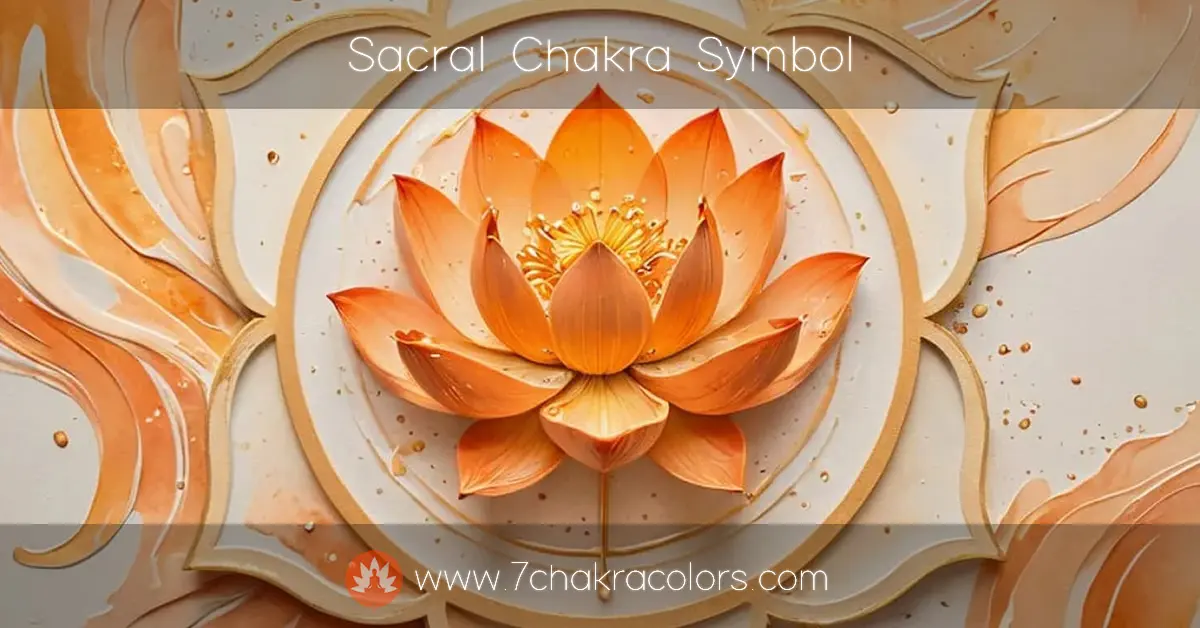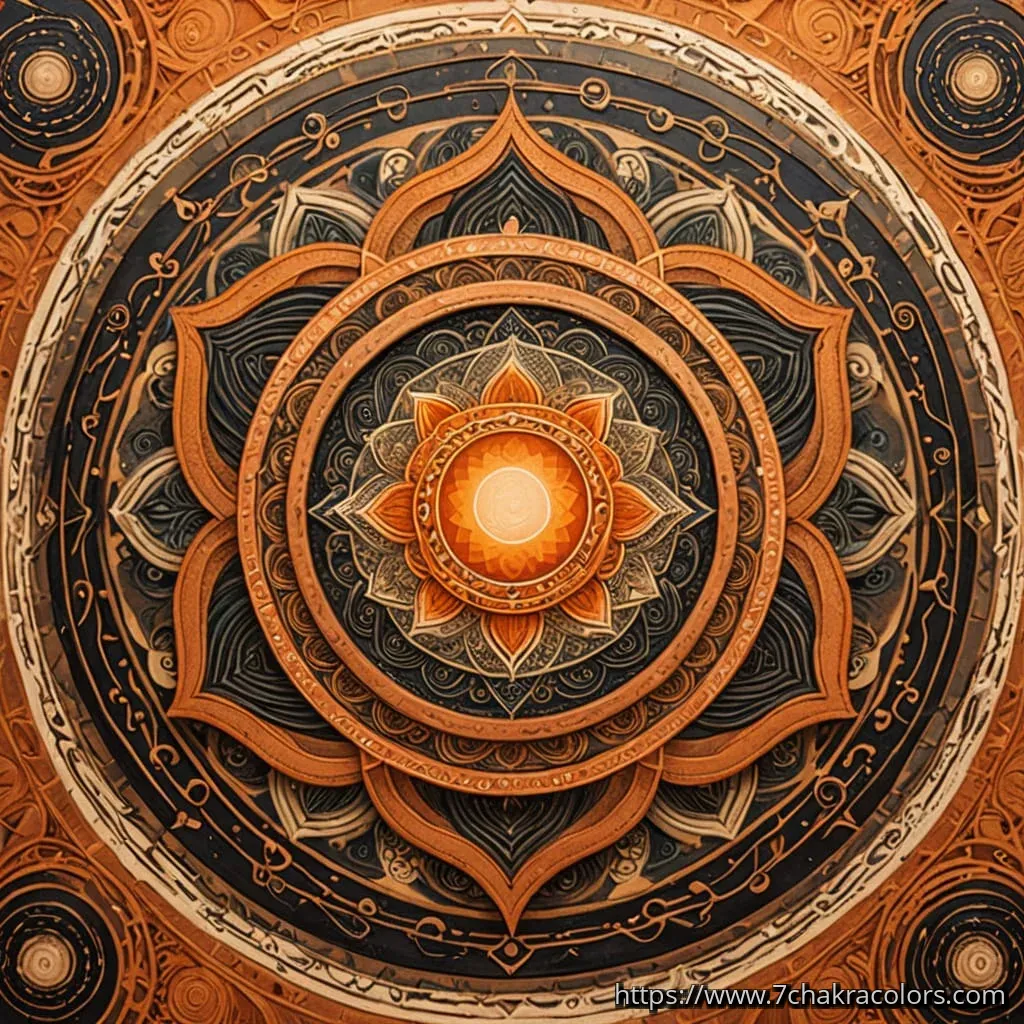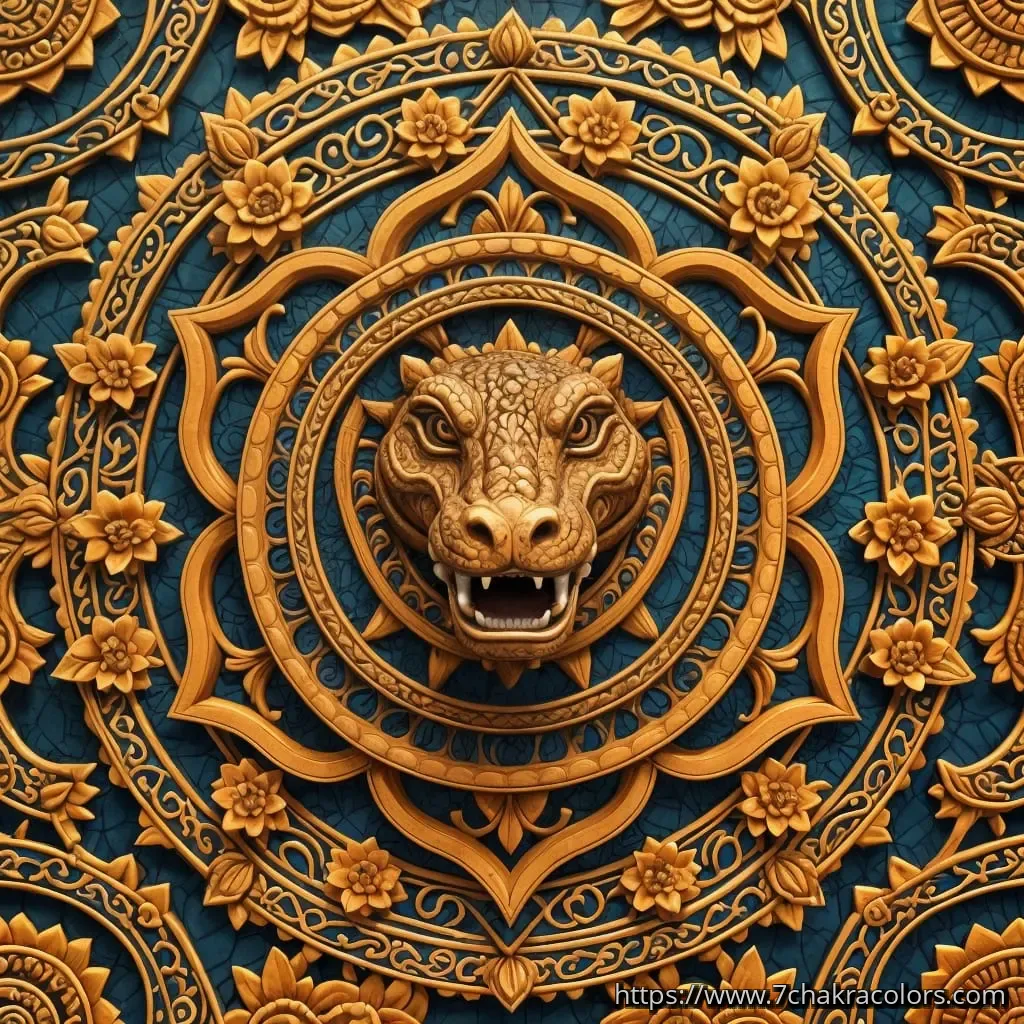

Discover the Sacral Chakra Symbol’s sacred geometry, traditional variations, and emotional significance. Find tattoo ideas, mantras, and resources for creative energy healing.
The Sacral Chakra symbol, also known as the Svadhisthana symbol, consists of a white crescent moon encircled by six orange lotus petals. This ancient symbol carries profound significance in yoga and meditation practices. The crescent moon represents the water element and the cyclical nature of emotions, creativity, and pleasure—the essential aspects of this chakra's energy. In sacred geometry, the crescent shape symbolizes receptivity, fluidity, and the tides of change.
The six lotus petals surrounding the crescent represent the six qualities or emotions associated with the Sacral Chakra: affection, playfulness, sensuality, creativity, joy, and enthusiasm. At the center of the symbol lies the Sanskrit letter "वं" (VAM), the seed sound or bija mantra that activates this chakra energetically.
Curious about what each chakra symbol represents? Click here to explore our comprehensive guide to all seven energy centers.
In Hindu tradition, the Sacral Chakra is associated with Vishnu, the preserver deity, particularly in his form as Varuna, god of water and cosmic order. This connection highlights the chakra's role in maintaining emotional balance and creative flow in our lives.
The Svadhisthana chakra appears in traditional Tantric texts dating back to the 7th and 8th centuries, where it was described as the seat of the unconscious and the storehouse of karmic impressions. In Buddhist traditions, particularly in Tibetan practices, this chakra is associated with pleasure, sexuality, and the emotional body.
The Sanskrit name "Svadhisthana" translates to "one's own place" or "dwelling place of the self," emphasizing its role as the center of our personal identity, creativity, and emotional expression. Just as water can be calm or turbulent, the energies of the Sacral Chakra reflect our emotional states and creative potential.



The Sacral Chakra symbol has gained popularity as a meaningful tattoo design, symbolizing creativity, emotional balance, and sensual energy. People often choose this symbol as a permanent reminder of their creative potential and emotional fluidity.
Common placements for a Sacral Chakra symbol tattoo include:
When considering a Sacral Chakra symbol tattoo, you might opt for:
Remember that tattoos carry energetic significance, and placing the Sacral Chakra symbol on your body can serve as a continuous reminder of your creative and emotional potential.
For those looking to incorporate the Sacral Chakra symbol into their meditation practice without a permanent tattoo, there are many options available:
These resources make it easy to incorporate the Sacral Chakra symbol into your daily life, whether through digital wallpapers, printed meditation cards, or custom altar decorations.
The Sacral Chakra symbol contains precise geometric forms that carry profound energetic significance.
The crescent moon shape represents fluidity, receptivity, and the water element—qualities essential to this second chakra.
In sacred geometry, the crescent symbolizes cycles, flow, and the feminine principle.
The circle that encompasses the entire symbol represents wholeness, continuity, and the cyclical nature of creativity and emotions.
The six-petaled lotus suggests the six directions of space (north, south, east, west, up, and down), indicating that emotional and creative energy permeates all dimensions of our existence.
Each geometric aspect of the Sacral Chakra symbol serves to channel specific frequencies of energy that relate to our emotional and creative capacities, facilitating a balanced flow of these vital life forces.

At the center of the Svadhisthana symbol lies the Sanskrit letter "वं" (VAM), the seed syllable or bija mantra associated with the Sacral Chakra. This sound vibration is considered the acoustic form of the chakra's energy.
When chanting the VAM mantra:
Sound practitioners and yogic traditions suggest that regular chanting of the VAM mantra can help balance emotional extremes and enhance creative flow. The sound vibration of VAM is said to penetrate the subtle body and activate the water element within us, promoting flexibility in both body and mind.
As a yantra (visual meditation tool), the Sacral Chakra symbol contains specific elements that facilitate meditation and energy alignment:
Each component works together to create a complete energy circuit that, when meditated upon, helps to organize and balance the Sacral Chakra energies, facilitating emotional harmony and creative expression.


The traditional orange color of the Sacral Chakra symbol carries specific vibrational qualities:
Color psychology research suggests that orange stimulates the nervous system, increasing energy and enthusiasm while promoting emotional balance—qualities that support the Sacral Chakra's association with creativity and emotional well-being. When working with the Sacral Chakra symbol for meditation or healing purposes, the specific shade of orange can influence the energetic effect.
Two primary animals are associated with the Sacral Chakra symbol:
Crocodile: The traditional mount (vahana) of this chakra. The crocodile symbolizes primal creative power and emotional instincts. In some traditional representations, a crocodile appears within or beneath the Sacral Chakra symbol, representing the powerful unconscious forces that drive our creative and emotional lives.
Fish: Representing the water element and adaptability. Fish symbolize the ability to navigate emotional waters with grace and move with the flow of life. In certain traditions, two fish may appear within the Sacral Chakra symbol, representing the balance of polarities in emotional and sexual expression.

The Sacral Chakra symbol appears with various modifications across different spiritual traditions:
Despite these variations, the essential components—the crescent, the six petals, and the central seed syllable—remain consistent across traditions, speaking to the universal nature of creative and emotional energy.
Hand positions (mudras) can enhance meditation with the Sacral Chakra symbol:
These hand positions help direct energy flow and enhance concentration when working with the Sacral Chakra symbol during meditation practices, facilitating a deeper connection to your emotional and creative centers.
The Sacral Chakra seed symbol "VAM" is the second in a sequence of bija mantras that progress through the chakra system:
This progression shows how the Sacral Chakra symbol and its seed mantra form a crucial bridge between our foundational survival instincts (Root Chakra) and our personal power (Solar Plexus Chakra), represented through sacred geometry and sound.
For those looking to work with the Sacral Chakra symbol in a hands-on way:
The practice of coloring or tracing the Sacral Chakra symbol can itself be a meditative act, helping to establish a deeper connection with your creative and emotional energies. Many find that the simple act of engaging with the symbol artistically helps to stimulate the very qualities the symbol represents.
Whether you choose to work with a physical representation of the Sacral Chakra symbol—through printed materials, digital images, jewelry, or even a tattoo—or simply visualize it during meditation, consistency is key. By regularly connecting with this powerful symbol, you establish a visual anchor for enhancing your creative flow and emotional balance.
Remember that the Sacral Chakra symbol is more than just a beautiful design—it's a doorway to accessing your creative potential, emotional intelligence, and sensual nature. As you deepen your relationship with this symbol, you may find that the very sight of it triggers a sense of creative inspiration and emotional fluidity that can enrich all aspects of your life.